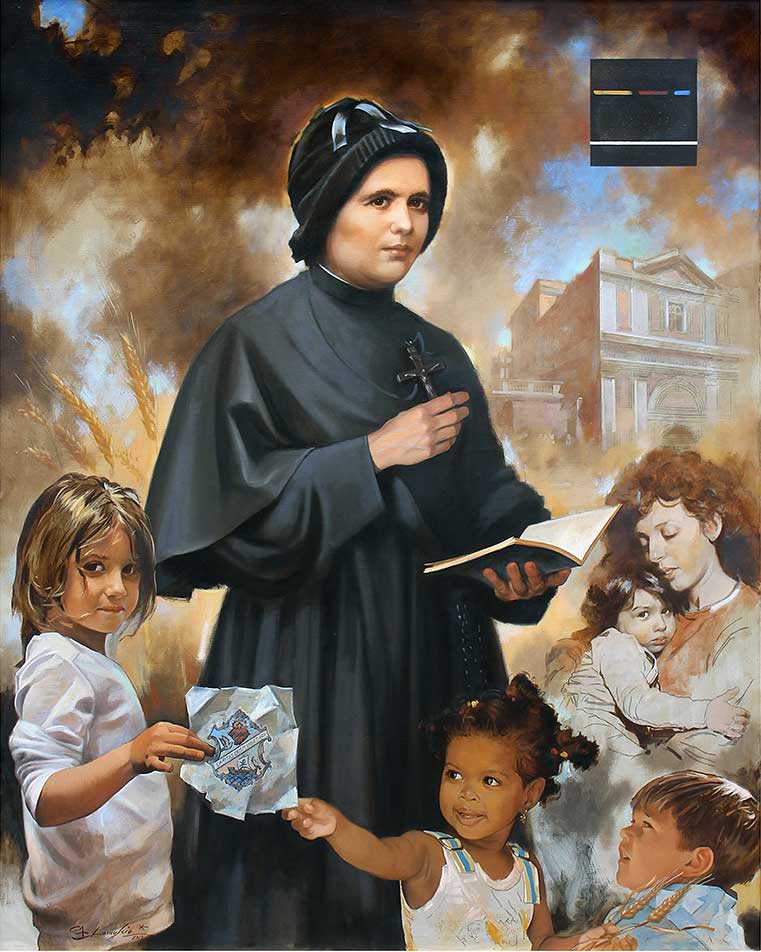
Title: “God’s plan for Clelia”
Technique: Oil painting
Dimension: 120×150 cm
Year: 2019
Author: Giuseppe Antonio Lomuscio
Iconographic Description of the Painting
This work was born out of the desire to create a new portrait of Blessed Clelia Merloni. With respect to a pre-existing and completed iconography, the result is an image that one may consider to be interpretational before being representational in that it is an interpretation of the action of the Holy Spirit moving through the life and works of Mother Clelia.
The image invites us to go beyond the surface and discover a privileged place for reflection, so useful for understanding a painting whose purpose is to catechize.
Portrayed here, more or less during the years of the founding of the Institute, is Blessed Clelia who occupies the central place in the composition enhanced by different subjects and elements that symbolically relate to her life and her great charism.
Her face, so peaceful and welcoming, has a loving expression that observes, guides and protects us and her hands with the crucifix and the open book express her charism of “Mother and Teacher” in its two foundational elements: reparation and evangelization.
Everything seems to revolve around her, but in reality the scene’s real center of gravity is the crucified Christ that Mother Clelia clings to and, at the same time, shows to us. The children around her, representative of different ages and ethnic backgrounds and during their growing years, are part of the narrative that recalls the educational and formative aspects that distinguish the mission and activity of the Apostles of the Sacred Heart still today.
In the piece other elements from Mother Clelia’s life and works are easily recognizable which express her charism: from the Generalate of the Congregation founded by her which is visible in the background, to the dark clouds reminiscent of the adversities that she faced in her life, to the stalks of wheat representing Mother Clelia’s humility and self-offering in giving her life for the Institute.
What is illustrated thus far, however, also presents a second key factor in the interpretation, one that may be less evident and striking, yet one that is more profound and noteworthy. It is a particular feature that inevitably captures the observer’s attention: the dark square in the upper right corner of the image.
This element, almost impossible to detect, is deliberately dark and of the same color as Mother Clelia’s habit, symbolizing how dark and unclear it must have been in the beginning to discern God’s plan for Clelia.
However, the piece contains a white line, like light, symbolizing the presence of God in Clelia’s life which has characterized and illuminated her journey. It is a continuous straight line, with neither beginning nor end, a symbol of eternity for God’s time is eternal. The three areas depicted by primary colors (also called “pure” colors because through them all other colors can be created) represent humanity which is oftentimes characterized by different experiences, but which if seen in the light of God’s presence can help find its true fulfillment.
Through these symbols in the painting, another central element emerges that is, however, difficult to represent: time. Not man’s time (kronos; Χρόνος), but God’s time (kairos; καιρός).
It is God’s time operative in the life of Mother Clelia that had a beginning (the plan represented by the square above), which evolved through Mother Clelia’s life experiences and her devotion to the Sacred Heart of Jesus, and resulting (not an ending…) in the works of the Institute that she founded and still continues today.
Therefore, the scroll held by the two young girls in the foreground, bearing the seal of the Congregation symbolizing the fulfillment of God’s plan for Clelia, closes and finalizes this divine plan, metaphorically represented by a timeline that can be traced graphically by diagonally connecting the three main elements of the composition viewed from the top to the bottom: starting from the black square, passing through the crucifix at the center of the piece and finally ending in the white scroll with the seal of the Institute.
In observing the faces of the subjects that are represented in the scene, it is also possible to discern another detail. The only glances that are directed toward the observer are, not surprisingly, those of the Blessed Mother, of the youngest child in the lap of the young mother to the right and finally that of the little girl holding the scroll in the foreground. They are the same gaze directed toward others which accompanies and follows us. It is as if they were the same gaze of Mother Clelia, a sign of a destiny already written from the beginning and which has grown over time and fulfilled through her works.
This painting, now seen in its own light, wishes to be a piece that provides an insight that tells and excites with the same generosity of the Apostles of the Sacred Heart of Jesus. In it one can find, as much as they wish, the light and the blessing of Mother Clelia who supports, sustains and guides the path of our life as believers.
Giuseppe Antonio Lomuscio